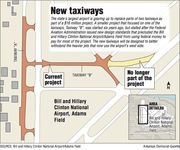A project to rehabilitate a taxiway at the state's largest airport that has been on the drawing board for six years appears to be back on track, bigger in scope and more expensive than when it was first conceived.
The rehabilitation of Taxiway B, or Bravo, at Bill and Hillary Clinton National Airport/Adams Field was approved by the Little Rock Airport Commission in 2009. Another version of the project is up for approval at the commission's regular monthly meeting Tuesday after two commission committees recommended the project last week.
Bravo is used by aircraft transitioning between Runway 4L/22R, one of the airport's two main commercial service runways, and the west, or general aviation, side of the field. It is a favorite of, among others, the Dassault Falcon private jets that are flown to Clinton National for completion to customer specifications, according to airport officials.
The taxiway features a high-speed exit from Runway 4L/22R when landing from the north.
"It is heavily used," said Tom Clarke, the airport's properties, planning and development director. "Our stakeholders really like to use it."
But that turned out to be a problem for the Federal Aviation Administration.
Design was almost completed on the project when the agency issued new guidance on runway and taxiway design standards, airport officials said. The new standards made the high-speed exit nonstandard and, thus, ineligible for FAA money. The agency also declined to "grandfather" the project.
Clarke said the changes in guidance was a response to increased concern about "runway incursions,"which the FAA defines as "involving the incorrect presence of an aircraft, vehicle or person on the protected area of a surface designated for the landing and take off of aircraft."
The agency wants to minimize those. One way is through design standards.
Under the new guidance, acute angle taxiways such as Bravo are ineligible for FAA funding. The taxiway also connects with a five-way intersection, which also is now ineligible for funding.
"They won't fund designs of complex geometry such as five-way intersections and acute-angle entries," Clarke said.
So it was back to the drawing board.
The new project continues the rehabilitation of the portion of Bravo that isn't part of the acute angle exit from the runway. It begins on the east edge of the intersection and goes east toward Runway 18/36 and the general aviation ramp.
Added to the project is rehabilitation of a section of Taxiway A, or Alpha, that intersects with and runs perpendicular to Bravo and along the front of the ramp covering much of the TAC Air general aviation center property.
"We have doubled the scope of the project as it was originally conceived," Clarke said.
The airport staff recommended adding Alpha to the scope of the project to take advantage of all FAA grant funds that will be available to the airport this year and next. Total estimated construction for the combined projects is $16.1 million, according to airport staff. The original project was estimated to cost about $9 million.
The new taxiway design will be built to withstand the heavier weights of the newer corporate aircraft, Clarke said.
Up for commission approval is a contract for the preliminary work, project administration, surveying, geotechnical investigations, coordination with the FAA and other stakeholders, preparation of design and construction documents and providing the bidding services for the project.
Garver LLC, a North Little Rock engineering firm and one of the companies that have an on-call engineering services agreement with the airport, will perform the work for $669,850. The cost would have been higher, but the airport was credited with $139,810 of work performed on the original project. The contract also includes a 10 percent contingency balance of $87,371.
Metro on 04/20/2015
